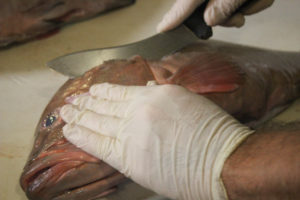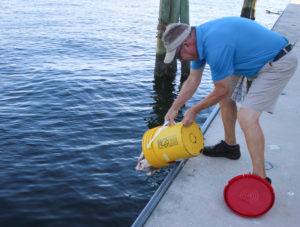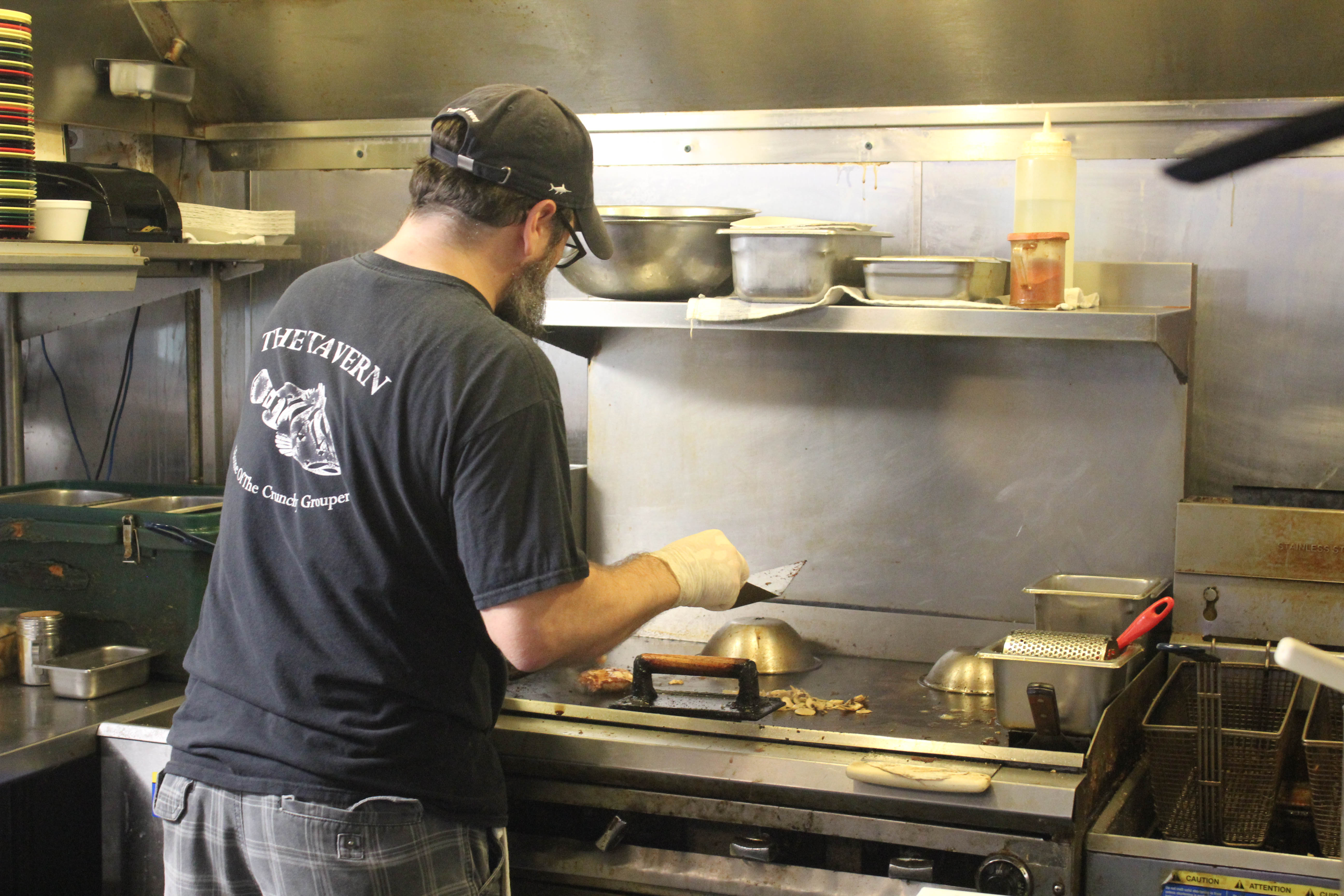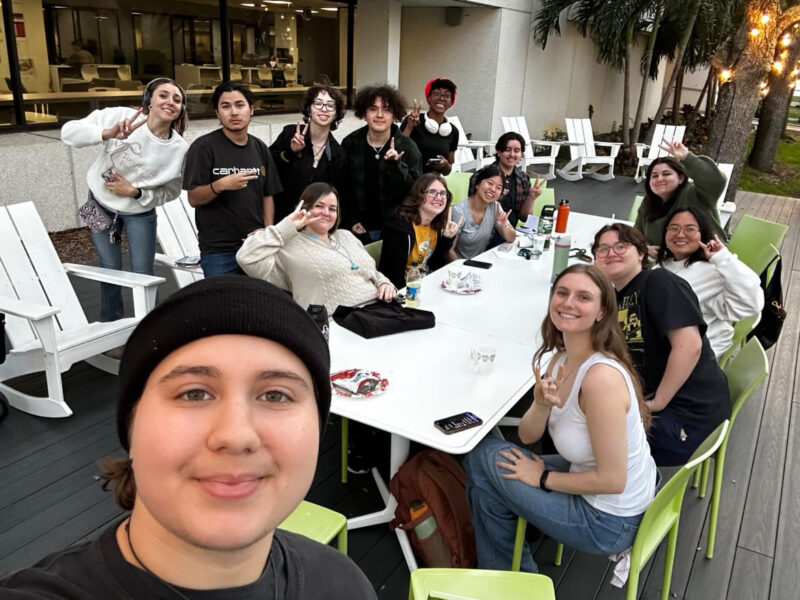Above photo: Patrick Bixler, assistant to The Tavern’s owner, utilizes every part of the grouper after butchering it through soups and stocks. Tim Fanning | The Crow’s Nest
By Tim Fanning
The Tavern at Bayboro’s inviting picnic tables and covered patio are packed with professors and students ready to kick back a couple of Bayboro Blonde Ales before the chaos of final exams begins.
It’s 11 a.m. — lunchtime.
The Tavern has been a fixture on campus since 1981 and is independent from the university. Here, you can enjoy a brief respite from exams, coursework and the stale cafeteria food offered nearby.
You are likely to meet owner Tom Herzhauser, who an hour ago finished filleting three whole red groupers at the fish filleting station near the cash register.
He estimates that in another two hours, he will have to fillet another three to keep up with the demand.
The $10 grouper sandwich is so popular that it rivals the Cuban and any of the four burgers as a top draw.
Herzhauser is like the mayor of USF St. Petersburg. He knows everyone and has friends everywhere — friends at Mastry’s Fresh Seafood in St. Petersburg and friends at Fish Busters in Madeira Beach.
With those kinds of friends, he has great access to red grouper: A fish you might say is to the Florida Gulf coast what lobster is to Maine.
Herzhauser buys 60 pounds of whole grouper a day, which he brings back to The Tavern in his gray 2004 Oldsmobile Silhouette to fillet himself.
Then he grills or deep fries it, selling 100 grouper filet sandwiches by closing time at 11 p.m.
Set between a soft, buttered and toasted homemade rosemary bun are two tomatoes, crisp romaine and a six-ounce fish. You can order it grilled, blackened or crusted with Corn Flakes and sliced almonds and deep fried.
Once considered a by-product in the 1980s, grouper has soared in popularity among seafood consumers.
In fact, the fish is so popular that Florida supplies about 80 percent of all grouper caught in the U.S., according to the Florida Fish and Wildlife Conservation Commission.
In 2016, 5.3 million pounds of grouper were commercially harvested and had an estimated value of $17.8 million, according to an FWC commercial fisheries and landing summary.
“We take it off the bone when we need it,” said Patrick Bixler, Herzhauser’s assistant. “You can’t get fish any fresher than you can here — unless you got a pond in the backyard.”
When it’s Bixler’s turn to prepare the fish, he starts by cutting out the cheeks, which he saves for The Tavern’s grouper cheek specials once a month.

The Tavern utilizes virtually every part of the fish, except for the fins and heads.
Grouper yield a high quantity of edible meat compared to its body weight. An 8-pound grouper, for example, produces over 3 pounds of edible flesh, Bixler said.
The Tavern uses the fillets for sandwiches and other parts for soups and stocks.
Bixler doesn’t use a regular flexible fillet knife, but a strange-looking firm one, which he says he learned to use when he worked at Holiday Seafood, a seafood wholesaler in Tarpon Springs. For seven years he filleted fish, shoveled ice and lugged 150 pounds of fish off boats.
“We cut them here because we can. It’s a big deal and takes a long time to learn how to process a fish. The fact that we can do it makes more sense for us to buy whole grouper because it keeps longer, it’s more fresh and we know what we’re getting,” Bixler said.
Tracing it back
As much as 30 percent of the seafood entering the United States is estimated to be mislabeled, undercutting U.S. fishermen, the nation’s seafood industry and consumers of up to an estimated $25 billion annually, according to the Tampa Bay Times.
It’s a problem the Tampa Bay area struggled with amid investigations years ago by the Times and others showing fake grouper being passed off as real to unwitting customers.
But The Tavern guarantees what it sells is real.
“Come on in and watch me cut up this fish,” Bixler said. “If I needed to, I could tell you, with a phone call, where this fish was caught, an average of how deep the water was, what bait was used and who caught it. We know because we go through the right channels. We can track this fish back to when it was alive.”

That’s because commercial fishermen include data of any species that are harvested and sold for human consumption. The state of Florida collects that data to generate statistics on the types of species and quantities landed, as well as the size, weight and age distribution of harvested species.
That information is reported on a Marine Fisheries Trip Ticket at the time the fishermen sell the fish to the wholesaler.
The trip ticket also includes information about the harvester, the dealer purchasing the fish, the date of the transaction, the county the fish was landed, the time fished and pounds of each species landed for each trip.
This information helps agencies like the FWC manage fish populations.
“If you have a good idea of what the whole (grouper) population looks like, and a good idea of what (fishermen) are removing from the population, it helps you manage it better what’s out there,” said Chris Bradshaw, an assistant research scientist for the fisheries dependent monitoring section at the Fish and Wildlife Research Institute.
“It’s like if someone brought a big bowl of M&M’s to a party and then asked you to find out how many green ones are in the bowl. What we do as dependent research scientists is that we ask the people munching on green M&M’s how much they had to eat to determine how many were actually in the bowl,” he said.
The bulk of Florida’s grouper harvest occurs in the Gulf of Mexico, and red grouper is the species most frequently sought, according to the FWC.
Red grouper are caught by slow-moving longline boats, which string miles of line with hundreds of soaked hooks at the bottom of the Gulf of Mexico.
Another fishing method is what’s known as “vertical line” fishing, sometimes known as “bandit rigs.”
This is a traditional method with one- or two-man crews anchored over specific spots, send a few lines down and wait for something to bite.
A bandit fisherman must stalk prey and anchor in deep water, fighting wind and current to hover over one small spot. Bandit boats might bring close to 2,000 pounds of grouper a trip, one-third as much as a longliner.
“These fishermen are real characters, with leather skin and veins full of salt,” Herzhauser said. “It’s a tough life.”
At the fish house, the fish are unloaded, measured, weighed and packed in ice. Within an hour, they are loaded in trucks to go anywhere from Miami to Canada.
Serving it fresh
Back at The Tavern, it’s about lunchtime, and prep cook Edward “Chubby” Smith is upstairs preparing the daily soup, mac and cheese, potato salad and coleslaw. He’s waiting for Bixler, who has finished filleting the four whole grouper Herzhauser bought that morning.
Darius Rucker’s “Wagon Wheel” twangs over the house radio as Smith lays out the ingredients to start prepping the crunchy grouper sandwich.
He takes about five minutes to prepare 10 or 15 fish filets.
“Everything here is homemade. Nothing is bought, except that tartar sauce,” Smith said, as he poured a whole cornflake cereal box into an aluminum pan filled with sliced almonds.
“It’s healthy for you. You got your protein, your cornflakes and the almonds,” he said. “I like the blackened grouper myself. But folks go crazy over this one right here. There’s this rich businessman who lives up in Fort Myers who flies all the way down here to eat the sandwich. He says it’s the best he’s ever tasted.”
The Tavern has won multiple Creative Loafing “Best of the Bay” awards since Herzhauser bought the place.
“Best College Hangout” and best “Grouper Sandwich in Tampa Bay: The Dardenne,” are awards Herzhauser displays with pride.
The sandwich was dedicated to Robert Dardenne, a beloved professor and one of the founding members of the journalism department at USF St. Petersburg, who died in 2013. He was 66.
Smith and Herzhauser met in 1998 and have been working together ever since. Wherever Herzhauser went, Smith went with him.
“I go with Tom because he’s a good guy. He knows what good food is and why that’s important,” Smith said as he brought the grouper fillets downstairs to be served for lunch.
He takes about 20 trips downstairs a day to the storage refrigerator next to the kitchen. Smith is halfway done today. Tomorrow, he’ll start over again at 7 a.m with a fresh batch of red grouper.



